Hydroaviation of the Japanese submarine fleet in World War II. Part VIII
A little known fact, but it is on-board a seaplane reconnaissance "Kugisho» E14Y1 (code name "Glen"), launched from aboard the submarine-I of 7, the day before, prior to the application in December 7 1941, the epoch-making impact of the Japanese carrier-based aircraft fleet on the American base in the Bay Porl- Harbor and other objects on the island of Oahu, made additional exploration purposes. His flight went unnoticed by the Americans and the plane returned safely to its carrier.
See Appendix for links to materials posted on 2017 website.
Submarine aircraft carriers
The successful practice of combat use of aircraft-carrying submarines in the initial period of the war in the Pacific Ocean, including in close proximity to the coast of North America, convinced the Naval General Headquarters of Japan at the very beginning of 1942 about the principal possibility of striking submarine-launched submarines on the mainland the territory of the United States. For inflicting tangible material damage in the event of such an attack, the fleet needs a full-fledged strike aircraft, and not an easy-bomber variant of a reconnaissance seaplane. In consequence of the I-25 aircraft carrying raid to the shores of the state of Oregon in September, 1942 clearly demonstrated the correctness of these judgments. For such new aircraft, other underwater carriers were required.
The proposal of the Marine General Staff on the need to build submarines - carriers of attack aircraft found its practical implementation in February 1942, when the commander of the Japanese United Fleet Admiral Yamomoto approved the plan to build a series of submarines of the type "Sen-Toku" ("Sensuican Toku" - a special submarine appointments) in the framework of the “Extraordinary Military Program of the 1942 of the Year”.
“Sen-Toku” (“STo”) submarines were supposed to carry three or four attack aircraft (dive torpedo bombers) with a combat load up to 1000 kg, have a cruising range up to 40 000 miles and have autonomy within four months.
The main purpose of the flotilla being built from 18 submarines of the type "Sen-Toku" (actually submarine aircraft carriers) was to become the Panama Canal. Destruction of the canal locks would significantly complicate the transfer of Allied forces and weapons from the Atlantic, from the European theater to the Pacific on detours, and allow the Japanese fleet to maintain its superiority on the Pacific theater (after hitting the US fleet in Pearl Harbor in December 1941) years) for a longer period.
Other plans for the combat use of Sen-Toku aircraft-carrying submarines were also considered - striking directly at the territory of the United States, in particular, at New York.
Diesel aircraft carrier submarine I-401 (type I-400 "Sen-Toku"), sea trials, 1945 year
The development and construction of these unique submarines (submarine aircraft carriers) unfolded at the Main Naval Arsenal in Yokosuka and shipyards in Kura and Sasebo, while practical applications of similar class of the Kai-Ko-Taka AM type were actively used. . The works were conducted in the strictest secrecy under the patronage of Admiral Yamamoto himself. The project “Sen-Toku” (production number “714”) was developing rapidly, the main one in the I-400 submarine series was laid down in less than a year - January 18 1943 at the shipyards in Kure. In the same year, four more submarines of the STo project were laid - two on cords in Sasebo (I-401 and I-402) and two in Kure (I-403 and I-404). In September, the sixth submarine of this type, the I-1944, was laid at the shipyards in Kure.
Diesel aircraft carrying submarines of type I-400 ("Sen-Toku") became the largest submarines built during the Second World War. They lost the palm in size only in the middle of the 60-ies of the XX century to a new class - nuclear submarines.
The submarine I-400 had a total surface displacement of 5223 tons (submerged 6560 tons) and the longest 122 meter. The width of the boat (the greatest) was 12 meters, and the height 7 meters.
Japanese submarine I-401 (type I-400 "Sen-Toku") at the pier, spring 1945 of the year
Durability with such gigantic dimensions was provided by a double-hulled construction - the robust case in the middle part had the shape of a horizontal figure eight (two cylinders were connected to each other by a high-strength longitudinal bulkhead), and this also made it possible to achieve an optimum height (draft). The flat sealed bulkheads inside the hull were divided into eight compartments.
To optimize the length of the boat, the engines of the power plant (four diesels with a total capacity of 7700 horsepower and two 1200-horsepower electric motors) were placed sequentially in two rows - each group of three engines worked on its own shaft line. To ensure the operation of diesel engines under water, there was a snorkel of the simplest design. The fuel supply for diesels was stored in tanks outside the robust hull, tanks for aviation gasoline were also placed here.
To reduce the noise of the boat on the go, all its main mechanisms had rubber-metal shock absorbers. In addition, to reduce acoustic and radar visibility, the elements of the light hull of the boat and the walls of the aircraft hangar were covered with a special rubber-based compound. Despite all the tricks to get rid of the big noise made by such large submarines, and failed.
Airborne submarine type I-400 ("Sen-Toku")
The submarine I-400 (“Sen-Toku”) developed in the surface position in the 18.7 nodes, and in the underwater 6.5 node. The maximum cruising range with an average speed of 14 nodes could be 37000 miles - an impressive figure! At the same time, the range of travel in a submerged position at the speed of a 3 node was just 60 miles. The boat had a working depth of diving 100 meters and autonomy in 90 days. The crew of I-400 (taking into account the air group) included the 144 person, the habitability conditions for its time were quite good.
In the central part of the boat, above the robust hull, there was a cylindrical aircraft hangar with a total length of 37,5 meters, which was closed in front with a massive door cover. Its internal diameter equal to the 3.5 meter and the length of the 34 meter were supposed to accommodate three strike seaplanes. The sturdy walls of the sealed hangar withstand the pressure of the outboard water when submerged to 100 meters. In the initial stage of work on the “STo” project, the hangar was supposed to hold only two aircraft, its length, as well as the size of the whole boat, was smaller (the total surface displacement was planned within 4550 tons).
A Japanese I-400 aircraft submarine hangar with a massive open lid-door in the foreground. The boat is moored to the American floating base, August 1945.
In the frontal view, the aviation hangar was slightly shifted from the centerline to the left, and the cabin of the boat was shifted to the right. The hangar and the cabin had a well-developed common fence and were equipped with platforms for placing anti-aircraft installations. From the durable hull of the boat there was a passage through a strong hatch into the hangar, it allowed to begin preparing aircraft for takeoff until the submarine emerged and shortened the total time it spent on the surface during aircraft launch, increasing survivability in combat conditions.
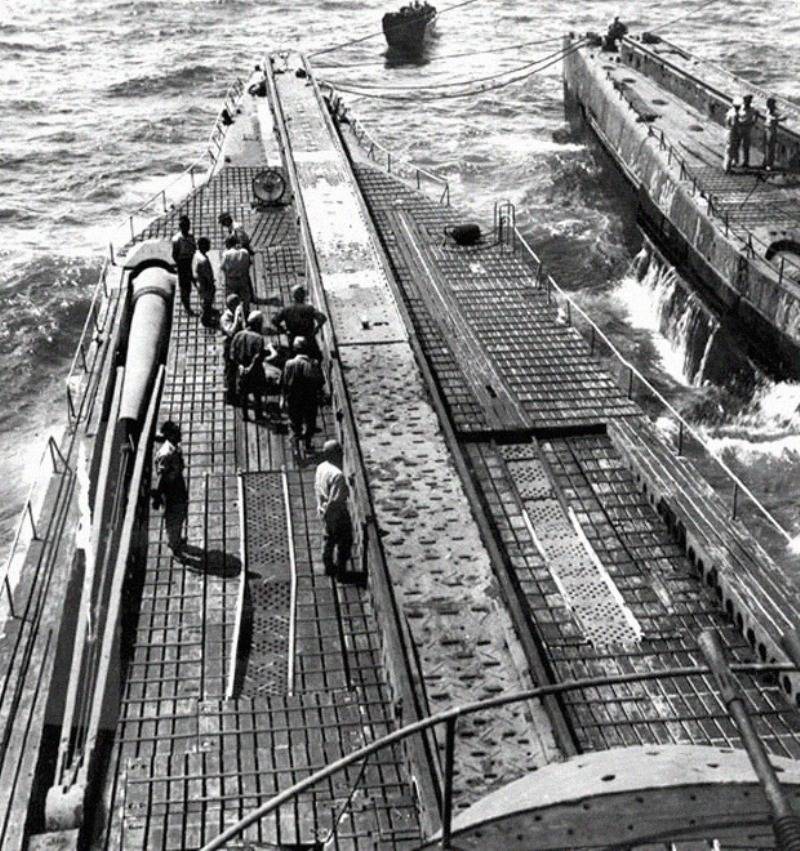
Starting track of the pneumatic catapult of the aircraft carrying submarine I-400, on the left side of the crane (in the stowed position) for lifting the floated plane to the deck, Pacific Ocean, 29 August 1944
A powerful pneumatic catapult Type 4 N1 mod 10 was placed in front of the hangar in the bow of the I-400. The length of its track was 26 meters (the length of the working section of the 21 meter), and the distance between the guides was equal to the 1.16 meter. The pressure in the system could vary from 90 to 150 atmospheres depending on the mass of the aircraft launched (maximum weight 5 tons). The starting track had an elevation angle equal to three degrees. The catapult accelerated the aircraft to a speed of 34 meters per second with an overload to 2.5 g. To reduce the time to prepare for the launch, impact seaplanes (without floats) were to be placed in the hangar on individual launch carts.
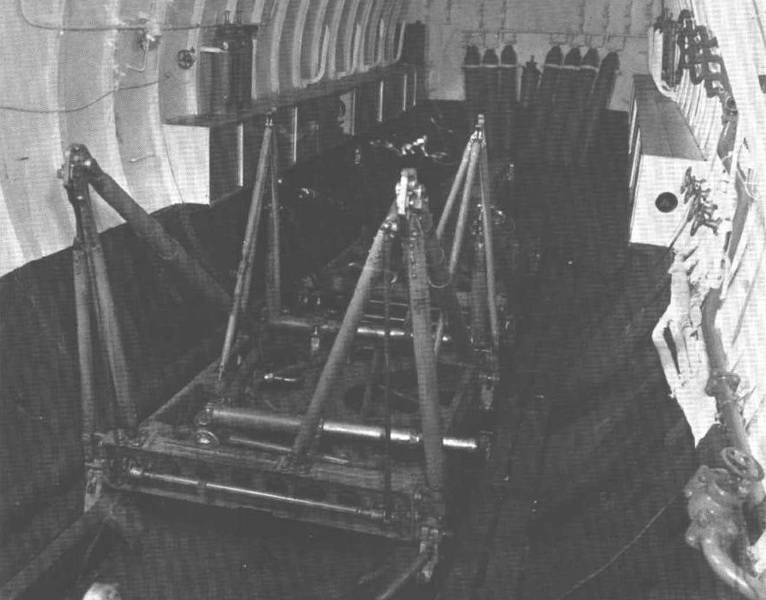
Launching trolley in the aircraft hangar submarines type I-400
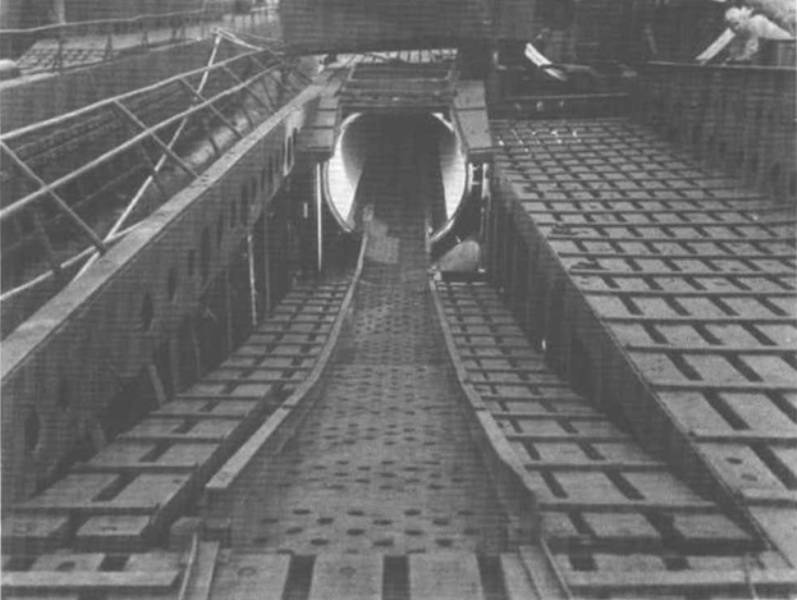
Cylinder container for storing seaplane floats
All launch carts were equipped with a hydraulic lifting device that allows the plane attached to it to be lowered when it is moved into the hangar, and raised from the catapult in preparation for the launch, while providing an additional angle of attack at 3,5 degrees.
To the right and left of the catapult near the hangar under the deck deck there were placed two sealed cylindrical containers for storing removable floats of hydroplanes (three in each). If necessary, mounted on special trolleys, the floats were fed to the deck (in pairs) along inclined ramps - sheets of deck flooring that were deflected downwards, which, in the stowed position, occupied their main position flush with the deck.
On the left side of the submarine in front of the hangar housed a crane with a lifting capacity of up to 12 tons. In the stowed position, it was folded and retracted into a special deck deepening. Its main purpose is to lift onto the deck of a boat after a seaplane crashes down.
140-mm aft gun for aircraft carrying submarine I-401 (firing range 17,5 km, firing rate of 6 shots per minute)
The I-400 torpedo armament consisted of eight 533-mm vehicles located in the nose, four on each side (20 torpedoes). The artillery armament was represented by the stern 140-mm gun, and the anti-aircraft armament - by three built-in 25-mm machine guns and one single-barreled 25-mm unit. To detect surface and airborne targets on the boat, there were corresponding radar stations.
In addition to the submarine aircraft carriers of the Sen-Toku type (as well as for fear that their creation could be delayed), the same year, the development and construction of similar specialized AM-class aircraft carrier submarines was carried out at Yokosuka and the shipyards in Kura. . The first boat of this type - I-13 was laid already 4 February 1943 of the year (two weeks after the tab I-400). Here in Kure, three more were laid during 1943: I-15, I-14 and I-1.
I-14 submarine in Tokyo Bay, 1945 year (picture taken from the board of the American naval base)
Submarines of this type were a reduced copy of Sen-Toku type submarines and were deep processing of cruising aircraft carrying submarines of the A1 / A2 (Ko-Gata) type. In contrast to Sen-Toku, the aircraft hangar (the inner diameter of the 3.5 meter) was designed to accommodate not three, but two strike aircraft. The AM boats had a similar pneumatic catapult Type 4 N1 mod 10, located in front of the hangar in the bow, as well as a special crane.
Compared with the А2 project, AM submarines had a wider hull, draft and displacement (in the surface position, it increased from 2934 to 3603 tons, and in the submarine from 4172 to 4762 tons) with a boat. The power plant had less power (two diesel engines for 2200 horsepower and two 600-strong electric motors), but was more economical. Meanwhile, the reduction of stocks of diesel fuel due to the placement of aviation-technical equipment led to a reduction in the cruising range - just 21000 miles with 16 nodes. The maximum speed in the surface position was the 16,7 node, and in the subsea - 5,5 node.
The boat I-13 had a working depth of diving 100 meters and autonomy 90 day. The crew (taking into account the air group) included 118 people, the conditions of habitability in comparison with the boat I-12 of the project А2 noticeably worsened.
Submarine I-14 under the American flag (140-mm stern gun from the boat was dismantled by the previous owners), September 1945 of the year
The conventional armament of the I-13 submarine included one 140-mm gun in the stern of the boat, six bow-mounted 533-mm torpedo tubes (stock of 12 torpedoes) and 25-mm anti-aircraft guns (two units and one single-barreled).
Of the six submarines of the type "Sen-Toku" and four types "AM" before the end of hostilities, only five entered the Japanese fleet: I-400, I-401, I-402, I-13 and I-14. The remaining boats were dismantled on the stocks or destroyed by a raid of American aircraft during construction (I-404). The I-402 had no aircraft armament; it was converted to a submarine supply tanker before delivery to the fleet.
Submarine I-402 (submarine supply tanker) in the port of Sasebo, 1945 year
Thus, for carrying out special strike operations, the Imperial fleet of Japan had only four submarine aircraft carriers: I-400, I-401, I-13 and I-14.
Submarine aircraft carriers I-14 and I-401 (view from starboard)
The main tactical and technical characteristics of Japanese aircraft-carrying submarines (submarine aircraft carriers) of the types "Sen-Toku" and "AM"
References:
1. Beshanov V.V. Encyclopedia of aircraft carriers / Edited by AE Taras - Moscow: AST, Minsk: Harvest, 2002 (Library of Military History).
2. Platonov A.V. Linear forces of the submarine fleet. - SPb .: Galeya Print LLC, 1998.
3. Dashyan A.V. Ships of the Second World War. Japanese Navy (part of 2). Maritime collection №7, 2004.
4. Ivanov S.V. Japan submarines 1941-1945. War at sea (№31). - Beloretsk: ARS LLC, 2006.
5. Okolelov N.N., Shumilin S.E., Chechin A.A. Submarine aircraft carriers of the Japanese fleet (history, design, aircraft armament). Maritime collection. - №7, 2007.
6. Kascheev L.B. Japanese submarines in World War II. Maritime collection №2. - 2011.
7. Firsov A. Aviation of Japan in the second world war. Part One: Aichi, Yokosuka, Kawasaki. Aviation collection №4. TsAGI, 1996.
8. Solomonov B., Kulagin K. Submarine aviation of the Yamato country. Aviamaster №3, 2003.
9. Doroshkevich O. Airplanes of Japan of the Second World War - Minsk: Harvest, 2004.
10. Chechin A., Okolelov N. Start from under the water. Model builder. - №№7, 8. - 2009.
11. Chechin A., Okolelov N. Ominous "Mountain Fog". Seaplane Aichi MXNUMHA "Seyran" and its predecessors // Aviation and time. " - №№6 — 4. - 6.
12. Haruk A.I. Attack aircraft of the Second World War - attack aircraft, bombers, torpedo bombers - M .: Yauza; Eksmo, xnumx.
13. Haruk A.I. All seaplanes of the second world. Illustrated color encyclopedia - M .: Yauza; Eksmo, xnumx.
14. Kotelnikov V. Aviation in the Second World War. Aircraft of France. Part of 1 (Aviation collection No. 10), 1996.
15. Kozyrev M., Kozyrev V. Aviation of Axis Countries in the Second World War - M .: CJSC “Tsentpoligraf”, 2010.
16. Bryukhanov A. Deck aircraft in World War II: An Illustrated Collection. Parts I-IV. - Publishing solutions (licensed by Ridero), 2017.
17. Bryukhanov A. Japanese submarine aviation in World War II: Publishing solutions (licensed by Ridero), 2017.
18. Gusev A.N. Submarines for special purposes. Built ships and unrealized projects - M .: Morkniga, 2013.
19. RJ Francillon. Japanese Aircraft of the Pacific. Putman & Company. London-1970.
20. Robert C. Mikesh. Aichi M6A1 Seiran, Japan's Submarine-Launched Panama Canal Bomber (Monogram Close-Up 13) - Monogram Aviation Publications. Commonwealth Press Worcester, Massachustts, 1975.
21. Japanese Military Aircraft Illustrated. Vol. 3, Reconnaissance Flying Boat Trainer / Transport - Bunrin-Do Co. Ltd., Tokyo 1983.
22. Robert C. Mikesh & Shorzoe Abe. Japanese Aircraft 1910-1941. Putnam Aeronautical Books, London, 1990.
23. Famous airplanes of the world №47. Imperial Japanese Navy Reconnaissance Seaplane - BUNRINDO Co.Ltd, Tokyo 1994.
24. Tadeusz Januszewski. Japanese Submarine Aircraft - Red Series (No. 5103). Mushroom Model Publications, 2002.
25. Ryusuke Ishiguro, Tadeusz Januszewski. Kugisho E14Y GLEN: The Aircraft that Bombed America (White Series) - MMPBooks, 2012.
26. ER Johnson. United States Naval Aviation, 1919-1941 - Aircraft, Airships and Ships Between the Wars. McFarland, 2011.
Internet resources:
http://blogspot.com;
http://wordpress.com;
http://wikimedia.org;
http://en.wikipedia.org;
http://www.sub-driver.com;
http://airandspace.si.edu;
http://www.stripes.com;
http://www.tinypic.com.
To be continued ...
- Alexander Bryukhanov
- Parts of the article posted on the website in 2017 year:
Hydroaviation of the Japanese submarine fleet in World War II. Part I ;
Hydroaviation of the Japanese submarine fleet in World War II. Part II ;
Hydroaviation of the Japanese submarine fleet in World War II. Part III ;
Hydroaviation of the Japanese submarine fleet in World War II. Part IV ;
Hydroaviation of the Japanese submarine fleet in World War II. Part V ;
Hydroaviation of the Japanese submarine fleet in World War II. Part VI ;
Hydroaviation of the Japanese submarine fleet in World War II. Part VII
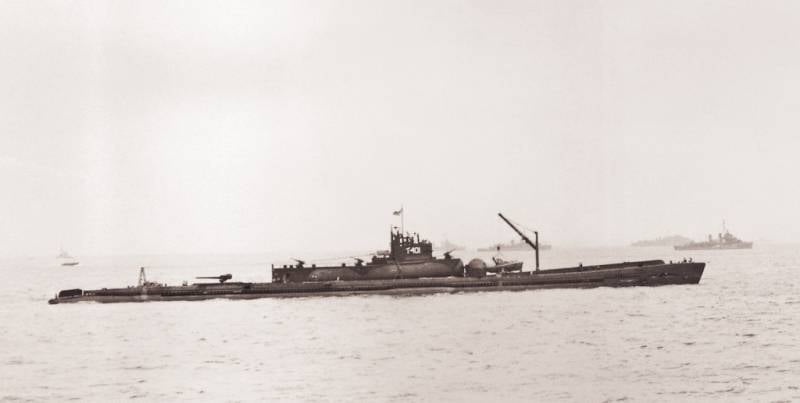
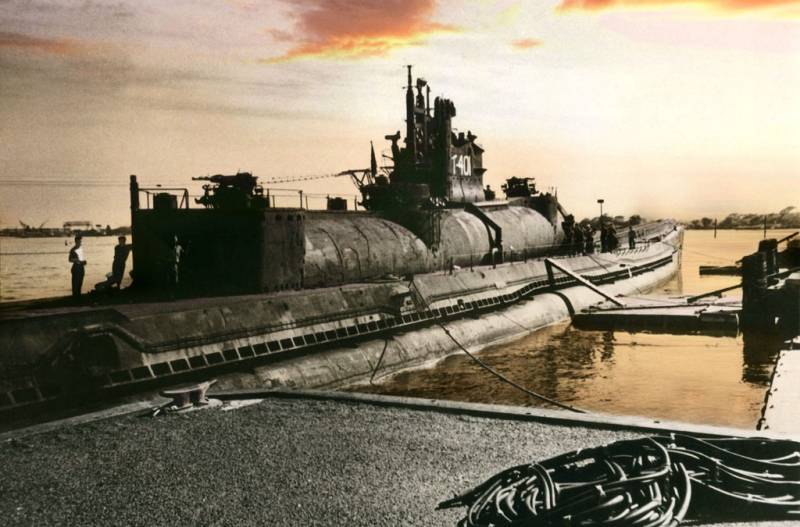
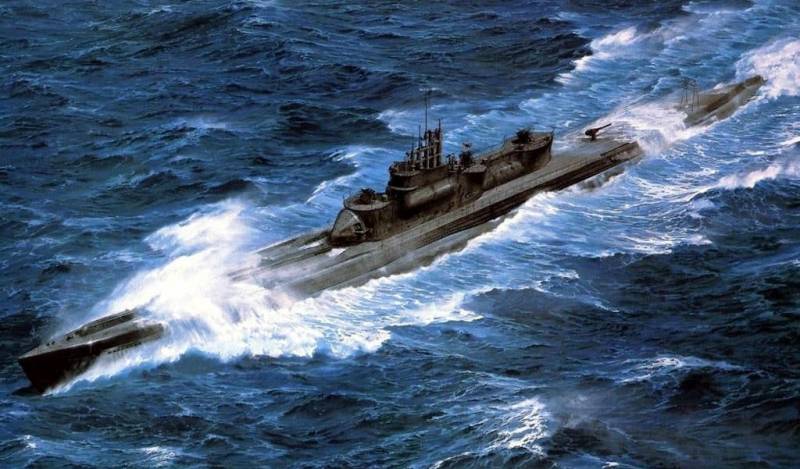
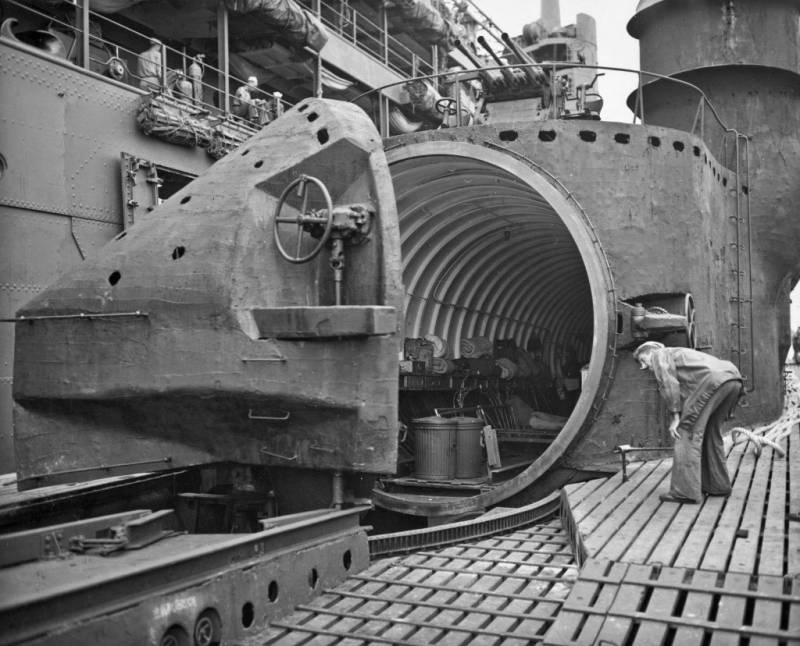
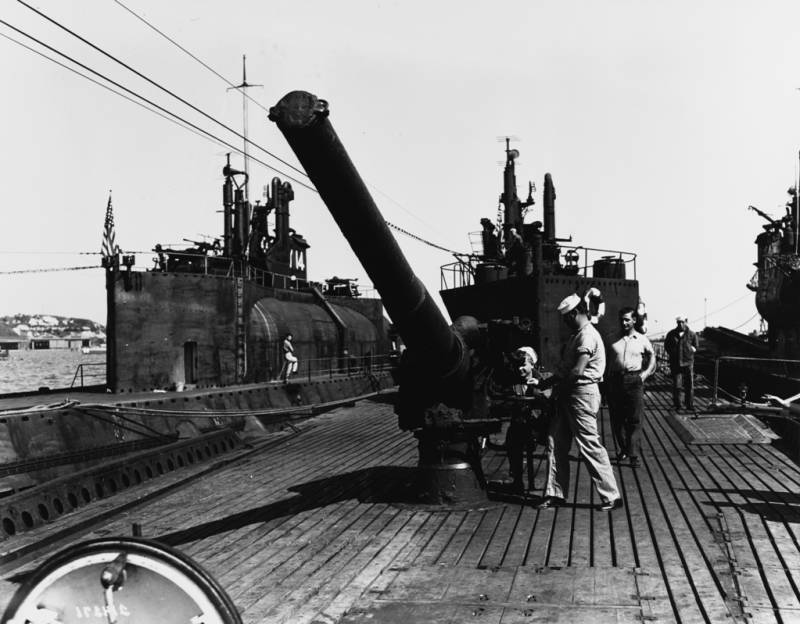
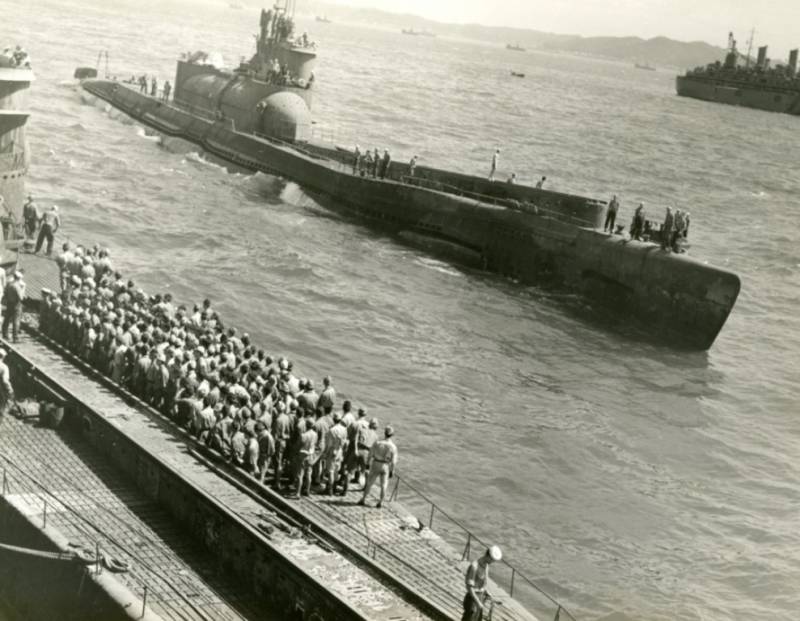
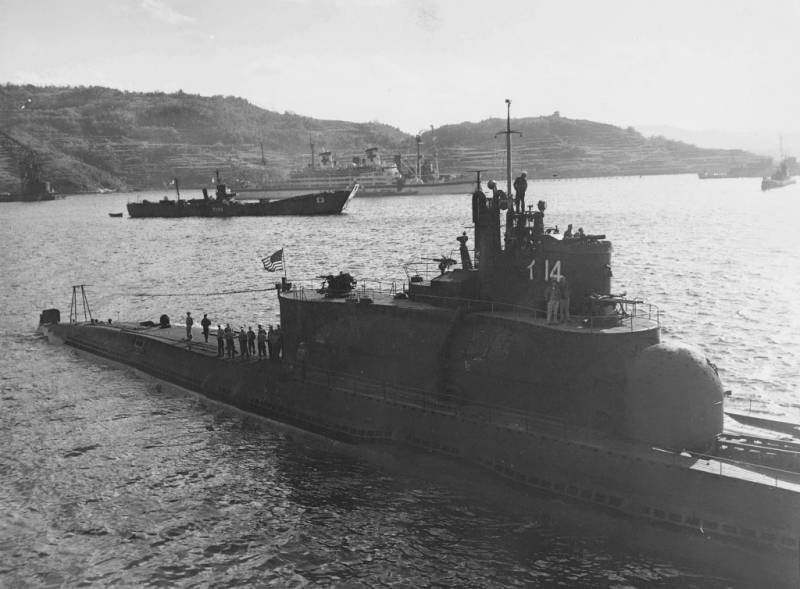
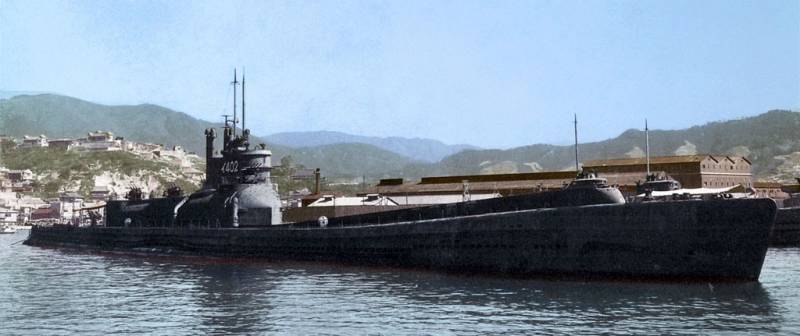
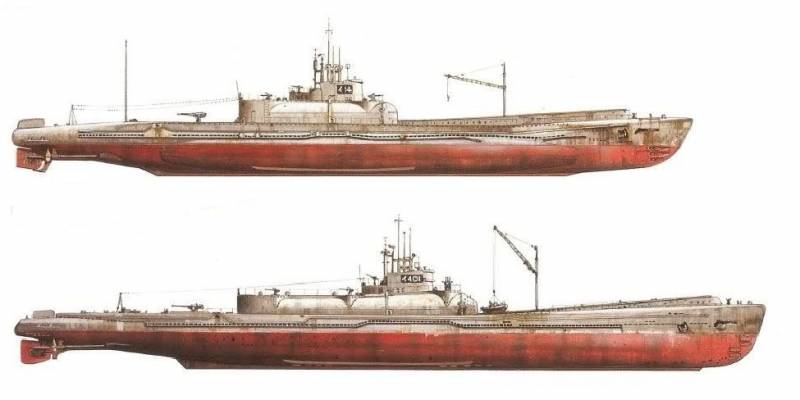
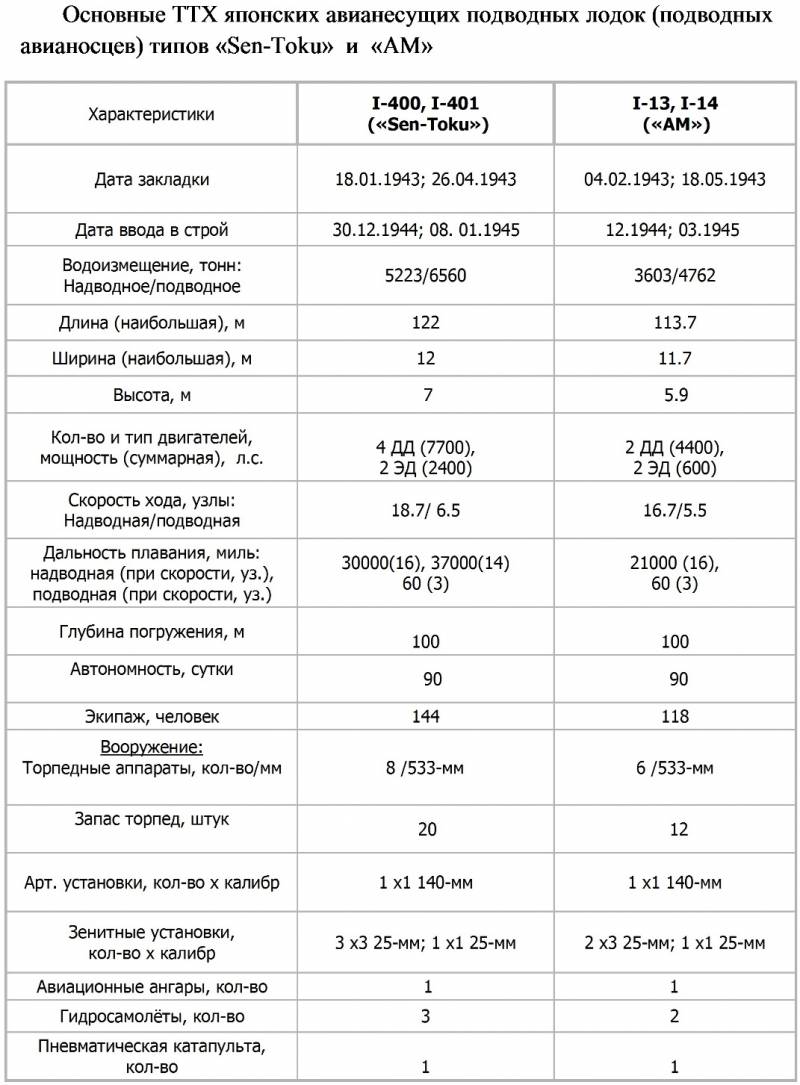
Information